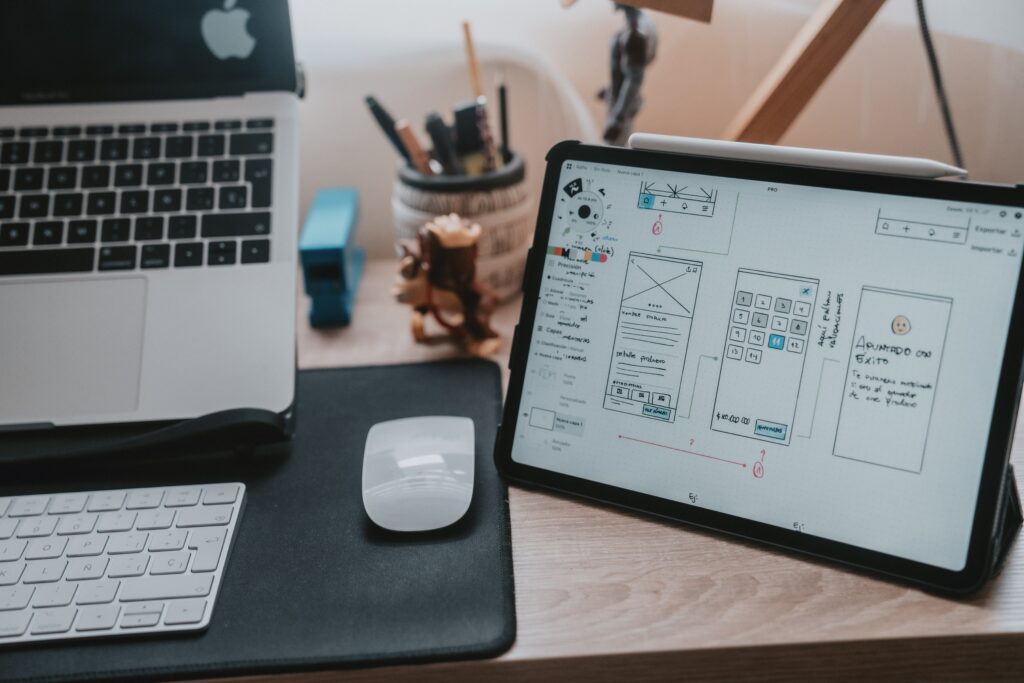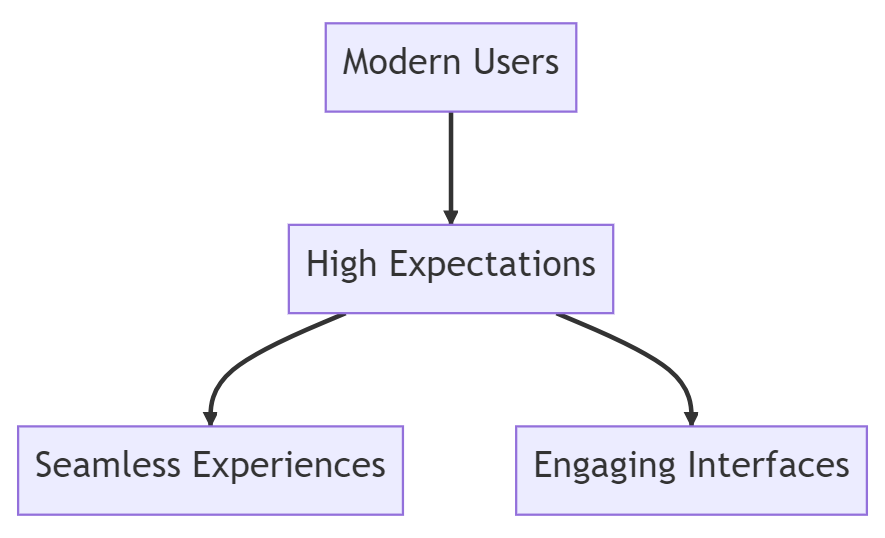
The Significance of UX/UI Design for Business Success
In the competitive digital landscape, outstanding UX/UI design is crucial for distinguishing a business from the competition. Those who prioritize user experience enhance customer satisfaction and retention. This for sure increases revenue and long-term success. A well-designed interface ensures seamless interactions, fosters trust, and creates a positive brand perception, all of which contribute to a strong online presence and an engaged, loyal customer base.
Meeting the Needs of Modern Users
Modern users demand seamless experiences that adapt to their preferred devices and platforms. To meet these expectations, businesses must deliver intuitive and engaging interfaces that provide consistent performance, personalized content, and smooth navigation.

By leveraging responsive design, implementing touch-friendly elements, and utilizing progressive web applications (PWAs), companies can create a user-centric experience that fosters customer satisfaction and loyalty. In doing so, businesses cater to users’ evolving needs and position themselves for long-term success in an increasingly competitive digital landscape.
Boosting Conversion Rates and Retention through UX/UI Design
An exceptional UX/UI design drives conversions and fosters customer loyalty. By streamlining site navigation, presenting information clearly, and facilitating desired actions, businesses can effectively guide users through their online journey and influence their decision-making process.
The Anatomy of a Winning UX/UI Design
To create a captivating UX/UI design, several elements must be considered, including usability, responsiveness, and aesthetics.
Simplifying Navigation and Content Structure
A clear and logical site structure and intuitive navigation ensure that users can effortlessly find the information they seek. Implementing techniques such as descriptive labels, well-organized menus, and breadcrumbs can help users understand their current location within site and easily navigate between pages.
Focusing on Readability and Scannability
Presenting content in a readable and scannable format is vital for retaining user attention. Businesses can convey information more effectively by employing easily digestible headings, bullet points, and short paragraphs. Additionally, clear typography and ample white space contribute to improved readability and a visually appealing design.
Streamlining the User Journey with Clear CTAs
Guiding users toward desired actions with strategically placed calls-to-action (CTAs) can significantly boost conversion rates. Effective CTAs should be visually prominent, use action-oriented language, and communicate the value proposition to encourage users to take the desired action.
Personalizing User Experiences
Personalization is key to enhancing user engagement and loyalty. Businesses can tailor content and recommendations to individual preferences by leveraging user data, creating a more relevant and compelling experience that drives conversions and encourages repeat visits.

Responsiveness: Adapting to Different Devices and Platforms
In 2023, the variety of devices and platforms users use to access digital content has grown exponentially. To maintain an edge in this competitive landscape, it’s crucial to ensure that your website is fully responsive and optimized for different devices and platforms.
Mobile-First Design Approach
A mobile-first design approach means crafting your UX/UI with mobile devices in mind from the start. This ensures that your website’s layout, typography, and images adapt seamlessly to various screen sizes and resolutions, creating a consistent user experience, regardless of the device they’re using.
Cross-Browser Compatibility
Ensuring cross-browser compatibility is essential for delivering a smooth user experience. This means that your website should function flawlessly and appear visually consistent across popular web browsers, such as Google Chrome, Mozilla Firefox, Safari, and Microsoft Edge.
Fluid Grid Layouts and Flexible Media
Fluid grid layouts and flexible media ensure that your website’s content and design elements automatically adjust to fit the screen size and orientation of the device being used. By implementing fluid grids, you can create a layout that dynamically scales and reorganizes content based on the viewport dimensions. Flexible media, such as images and videos, should also be configured to resize and maintain their aspect ratio to prevent distortion or cropping on different devices.
Touch-Friendly Design
With the prevalence of touch-based devices like smartphones and tablets, it’s essential to incorporate touch-friendly design elements into your UX/UI. This includes creating larger, easily tappable buttons and links and ensuring adequate spacing between interactive elements to prevent accidental taps.
The Future of UX/UI Design: Anticipating Evolving Trends
As technology continues to advance and user expectations evolve, it’s crucial for businesses to stay ahead of the curve by anticipating and adapting to new UX/UI design trends.
Voice User Interfaces (VUIs) and Natural Language Processing (NLP)
Voice user interfaces and natural language processing technologies have become increasingly popular, enabling users to interact with devices using voice commands. By incorporating VUIs and NLP into your UX/UI design, you can provide a more engaging and intuitive experience for users.
Immersive Experiences: Augmented Reality (AR) and Virtual Reality (VR)
Augmented reality and virtual reality technologies have the potential to revolutionize UX/UI design, offering users immersive experiences that blur the line between the digital and physical worlds. Embracing these technologies can help businesses create unique, memorable user experiences that set them apart from their competitors.
Augmented Reality (AR) Applications
AR overlays digital information onto the user’s real-world environment, enhancing their experience by providing contextually relevant information or interactive elements. AR can be applied across various industries, such as retail, education, and entertainment. For instance, retailers can use AR to allow customers to try on products virtually, while educators can create interactive learning materials to enrich students’ understanding of complex concepts.
Virtual Reality (VR) Experiences
VR fully immerses users in a digital environment. This provides a sense of presence and enables them to interact with their surroundings. VR can be utilized in various sectors, such as gaming, tourism, and training. In gaming, users can engage in immersive experiences that transport them to different worlds. In tourism, virtual tours can provide users with a realistic preview of travel destinations. At the same time, in the training sector, VR can be employed to simulate real-world scenarios for skill development.
Design Principles for AR and VR
When incorporating AR and VR technologies into UX/UI design, it’s essential to follow specific design principles to ensure a user-friendly experience:
- Intuitive interactions: Design natural, gesture-based interactions that leverage users’ familiarity with real-world actions, such as grabbing, pinching, or swiping.
- Spatial audio: Utilize spatial audio to enhance the sense of immersion and guide users through the experience.
- Comfort and accessibility: Prioritize user comfort and accessibility by designing experiences that cater to diverse user needs and abilities. This includes considering factors such as motion sickness, visual impairments, and physical limitations. Implement features like adjustable text size, alternative input methods, and customizable comfort settings to create inclusive user experiences.
- Clear guidance and feedback: Provide users with clear instructions and feedback to help them navigate the virtual environment effectively. This can include visual cues, auditory prompts, or haptic feedback to guide users through tasks and interactions.
- Optimized performance: Ensure that AR and VR experiences run smoothly on various devices by optimizing performance. This includes efficient use of resources, minimizing latency, and ensuring consistent frame rates to prevent motion sickness and provide a seamless experience.

Conclusion: Investing in UX/UI Design for Long-Term Success
In 2023, exceptional UX/UI design will be indispensable for businesses aiming to thrive in the digital landscape. You can create captivating experiences that meet modern users’ expectations by prioritizing usability, responsiveness, and aesthetics. Furthermore, embracing emerging technologies like AR and VR can set your business apart, providing unique, immersive experiences that engage and delight users.
Investing in UX/UI design helps you attract and retain customers and contributes to long-term business success. Stay ahead of evolving trends and continuously refine your UX/UI design to maintain a competitive edge and ensure your users’ satisfaction for years to come.